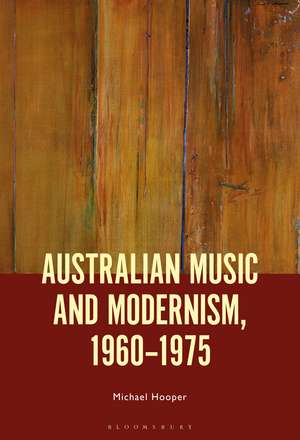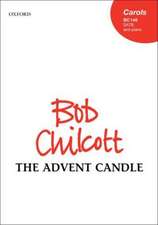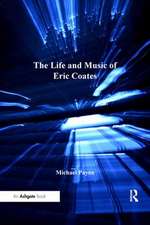Australian Music and Modernism, 1960-1975
Autor Dr. Michael Hooperen Limba Engleză Hardback – 30 oct 2019
| Toate formatele și edițiile | Preț | Express |
|---|---|---|
| Paperback (1) | 199.56 lei 6-8 săpt. | |
| Bloomsbury Publishing – 29 dec 2021 | 199.56 lei 6-8 săpt. | |
| Hardback (1) | 774.62 lei 6-8 săpt. | |
| Bloomsbury Publishing – 30 oct 2019 | 774.62 lei 6-8 săpt. |
Preț: 774.62 lei
Preț vechi: 1113.40 lei
-30% Nou
Puncte Express: 1162
Preț estimativ în valută:
148.23€ • 155.15$ • 123.37£
148.23€ • 155.15$ • 123.37£
Carte tipărită la comandă
Livrare economică 31 martie-14 aprilie
Preluare comenzi: 021 569.72.76
Specificații
ISBN-13: 9781501348181
ISBN-10: 1501348183
Pagini: 320
Ilustrații: 7 bw illus
Dimensiuni: 152 x 229 mm
Greutate: 0.57 kg
Editura: Bloomsbury Publishing
Colecția Bloomsbury Academic
Locul publicării:New York, United States
ISBN-10: 1501348183
Pagini: 320
Ilustrații: 7 bw illus
Dimensiuni: 152 x 229 mm
Greutate: 0.57 kg
Editura: Bloomsbury Publishing
Colecția Bloomsbury Academic
Locul publicării:New York, United States
Caracteristici
Offers a history of Australian music as it resolved into a recognizable national form from 1960 to 1975
Notă biografică
Michael Hooper is Senior Lecturer in Music at the University of New South Wales, Australia, where from 2012 to 2015 he was an ARC Research Fellow. He is the author of The Music of David Lumsdaine (2012) and Roger Smalley on Music (2018).
Cuprins
List of ExamplesList of FiguresList of TablesPermissionsAcknowledgementsIntroduction: Australian Music Now1. The Formation of an Academic Discourse of Australian Music2. Infrastructure for New Music, Serial Technique and Don Banks's String Quartet (1975)3. Richard Meale I: Sydney4. Nigel Butterley: Australian Music and Britain5. Peter Sculthorpe: Australian Music and Nationalism6. Richard Meale II: Adelaide7. Landscapes in painting and literature: Lumsdaine and SculthorpeNotesBibliographyIndex
Recenzii
As a close study of five significant Australian composers, the work is a useful contribution to the literature. Hooper has extensive access to archives, interviews and correspondence, some which have become newly available. Hooper uses these sources to establish a history of the construction of infrastructure which underlies the explosion of postmodern music in Australia after 1975.
The third quarter of the 20th century was a time of particular turbulence for classical composers, when both extreme conservatives and intransigent radicals could have successful careers. Michael Hooper traces the progress of a group of Australian composers in an unstable cultural world of striking polarities - national, international: traditional, progressive. As he shows in telling technical detail, a distinctive musical identity might involve exploring how opposed extremes can either converge or diverge: and by homing in on explicitly Australian contexts that involve painters, writers, academics and even politicians, Hooper's well-documented analyses capture the most memorable qualities of compositions from a time when post-tonal modernism remained a positively mainstream concern.
Michael Hooper's Australian Music and Modernism: 1960-75 presents a rigorously researched and original account of a decisive but often overlooked period in Australian music. Whereas most current understandings of Australian contemporary music focus on the country's turn towards postmodernist nationalism around 1975, the author demonstrates that this period was preceded by a deep and intimate engagement with international modernism. The book is a must for everyone interested in Australian music or musical modernism.
Replete with rich analytical detail, Hooper's book throws into relief the complexities of a regionally-specific project of becoming musically modern. Most impressively, by tracking shifts in compositional attitudes and techniques, musicological discourse and public reception over a fifteen-year period, Hooper elegantly reveals the ways modernism and nationalism can shape artistic narratives.
This ambitious book represents a substantial advance in the scholarly documentation of a crucial period in Australia's musical development.
Australian Music and Modernism is an important contribution to the scholarly literature and a welcome acquisition to the bookshelves of scholars interested in this topic.
The third quarter of the 20th century was a time of particular turbulence for classical composers, when both extreme conservatives and intransigent radicals could have successful careers. Michael Hooper traces the progress of a group of Australian composers in an unstable cultural world of striking polarities - national, international: traditional, progressive. As he shows in telling technical detail, a distinctive musical identity might involve exploring how opposed extremes can either converge or diverge: and by homing in on explicitly Australian contexts that involve painters, writers, academics and even politicians, Hooper's well-documented analyses capture the most memorable qualities of compositions from a time when post-tonal modernism remained a positively mainstream concern.
Michael Hooper's Australian Music and Modernism: 1960-75 presents a rigorously researched and original account of a decisive but often overlooked period in Australian music. Whereas most current understandings of Australian contemporary music focus on the country's turn towards postmodernist nationalism around 1975, the author demonstrates that this period was preceded by a deep and intimate engagement with international modernism. The book is a must for everyone interested in Australian music or musical modernism.
Replete with rich analytical detail, Hooper's book throws into relief the complexities of a regionally-specific project of becoming musically modern. Most impressively, by tracking shifts in compositional attitudes and techniques, musicological discourse and public reception over a fifteen-year period, Hooper elegantly reveals the ways modernism and nationalism can shape artistic narratives.
This ambitious book represents a substantial advance in the scholarly documentation of a crucial period in Australia's musical development.
Australian Music and Modernism is an important contribution to the scholarly literature and a welcome acquisition to the bookshelves of scholars interested in this topic.

















